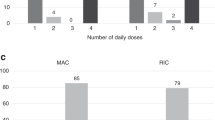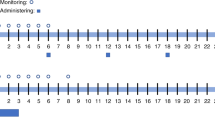Abstract
This report describes and critically appraises our experience with busulfan dose adjustment in children undergoing bone marrow transplant between April 1997 and March 1999. All children received an initial busulfan dose of 40 mg/m2 p.o. or by nasogastric tube. Whole blood samples were obtained 1, 1.5 and 6 h later and analyzed for busulfan content by gas chromatography with electron capture detection. The area under the whole blood busulfan concentration vs time curve (auc) and an individualized dose which would achieve an auc of 1300 μm/min were calculated. mean and median busulfan doses were calculated using actual, ideal and effective body weight and stratified according to age. the relationship between the busulfan concentration at hour 6 and auc was determined using linear regression. thirty-nine courses of busulfan were evaluated in 38 patients. a change from the initial busulfan dose was required to achieve the target auc in 34 courses (87%). most children >1 to 5 years old required dose increments while most children >5 years old required dose reductions. Obesity did not significantly affect busulfan dose requirements. Busulfan concentrations at 6 h only weakly predicted the AUC achieved (r2 = 0.496; P = 0.001). Based on these findings, we recommend that the initial busulfan dose be assigned according to patient age and actual body weight. We also recommend that busulfan AUC be calculated for children using a four-sample (1, 1.5, 4 and 6 h) limited sampling technique. Bone Marrow Transplantation (2000) 26, 1143–1147.
This is a preview of subscription content, access via your institution
Access options
Subscribe to this journal
Receive 12 print issues and online access
$259.00 per year
only $21.58 per issue
Buy this article
- Purchase on Springer Link
- Instant access to full article PDF
Prices may be subject to local taxes which are calculated during checkout
Similar content being viewed by others
References
Dix SP, Wingard JR, Mullins RE et al. Association of busulfan area under the curve with veno-occlusive disease following BMT Bone Marrow Transplant 1996 17: 225–230
Ljungman P, Hassan M, Bekassy AN et al. High busulfan concentrations are associated with increased transplant-related mortality in allogenic bone marrow transplant patients Bone Marrow Transplant 1997 20: 909–913
Slattery JT, Sanders JE, Buckner CD et al. Graft-rejection and toxicity following bone marrow transplantation in relation to busulfan pharmacokinetics Bone Marrow Transplant 1995 16: 31–42
Slattery JT, Clift RA, Buckner CD et al. Marrow transplantation for chronic myeloid leukemia: the influence of plasma busulfan levels on the outcome of transplantation Blood 1997 89: 3055–3060
Bolinger AM, Zangwill AB, Slattery JT et al. An evaluation of engraftment, toxicity and busulfan concentration in children receiving bone marrow transplantation for leukemia or genetic disease Bone Marrow Transplant 2000 25: 925–930
Chattergoon DS, Saunders EF, Klein J et al. An improved limited sampling method for individualised busulphan dosing in bone marrow transplantation in children Bone Marrow Transplant 1997 20: 347–354
Dupuis LL, Armstrong C . Oral syringe for extemporaneously preparing doses Am J Health-Syst Pharm 1998 55: 735
Gibaldi M . Biopharmaceutics and Clinical Pharmacokinetics, 4th edn Lea & Febiger: Philadelphia 1991 pp 377–378
Haycock GB, Schwartz GJ, Wisotsky DH . Geometric method for measuring body surface area: a height-weight formula validated in infants, children, and adults J Pediatr 1978 93: 62–66
Traub SL, Kichen L . Estimating ideal body mass in children Am J Hosp Pharm 1983 40: 107–110
Hassan M, Ljungman P, Bolme P et al. Busulfan bioavailability Blood 1994 84: 2144–2150
Vassal G, Fischer A, Challine D et al. Busulfan disposition below the age of three: alteration in children with lysosomal storage disease Blood 1993 82: 1030–1034
Poonkuzhali B, Srivastava A, Querin MH et al. Pharmacokinetics of oral busulphan in children with beta thalassaemia major undergoing allogeneic bone marrow transplantation Bone Marrow Transplant 1999 24: 5–11
Schuler U, Schroer S, Kühnle A et al. Busulfan pharmacokinetics in bone marrow transplant patients: is drug monitoring warranted? Bone Marrow Transplant 1994 14: 759–765
Slattery JT, Risler LJ . Therapeutic monitoring of busulfan in hematopoietic stem cell transplantation Ther Drug Monit 1998 20: 543–549
Pawlowska AB, Blazar BR, Angelucci E et al. Relationship of plasma pharmacokinetics of high-dose oral busulfan to the outcome of allogeneic bone marrow transplantation in children with thalassemia Bone Marrow Transplant 1997 20: 915–920
Hassan M, Fasth A, Gerritsen B et al. Busulphan kinetics and limited sampling model in children with leukemia and inherited disorders Bone Marrow Transplant 1996 18: 843–850
Vassal G, Deroussent A, Challine D et al. Is 600 mg/m2 the appropriate dosage of busulfan in children undergoing bone marrow transplantation? Blood 1992 79: 2475–2479
Hassan M, Oberg G, Bekassy AN et al. Pharmacokinetics of high-dose busulphan in relation to age and chronopharmacology Cancer Chemother Pharmacol 1991 28: 130–134
Slattery JT, Sanders JE, Buckner CD et al. Graft-rejection and toxicity following bone marrow transplantation in relation to busulfan pharmacokinetics Bone Marrow Transplant 1995 16: 31–42
Gibbs JP, Liacouras CA, Baldassano RN et al. Up-regulation of glutathione S-transferase activity in enterocytes of young children Drug Metab Dispos 1999 27: 1466–1469
Gibbs JP, Gooley T, Corneau B et al. The impact of obesity and disease on busulfan oral clearance in adults Blood 1999 93: 4436–4440
Kasai M, Kiyama Y, Watanabe M et al. Toxicity of high-dose busulfan and cyclophosphamide as a preparative regimen for bone marrow transplantation Transplant Proc 1992 24: 1529–1530
Slattery JT, Clift RA, Buckner CD et al. Marrow transplantation for chronic myeloid leukemia: the influence of plasma busulfan levels on the outcome of transplantation Blood 1997 89: 3055–3060
Author information
Authors and Affiliations
Rights and permissions
About this article
Cite this article
Dupuis, L., Najdova, M. & Saunders, E. Retrospective appraisal of busulfan dose adjustment in children. Bone Marrow Transplant 26, 1143–1147 (2000). https://doi.org/10.1038/sj.bmt.1702700
Received:
Accepted:
Published:
Issue Date:
DOI: https://doi.org/10.1038/sj.bmt.1702700
Keywords
This article is cited by
-
Age-dependent pharmacokinetic profile of single daily dose i.v. busulfan in children undergoing reduced-intensity conditioning stem cell transplant
Bone Marrow Transplantation (2009)
-
Intravenous busulfan in children prior to stem cell transplantation: study of pharmacokinetics in association with early clinical outcome and toxicity
Bone Marrow Transplantation (2005)
-
Randomized trial of two different conditioning regimens for bone marrow transplantation in thalassemia – the role of busulfan pharmacokinetics in determining outcome
Bone Marrow Transplantation (2005)
-
Busulphan given as four single daily doses of 150 mg/m2 is safe and effective in children of all ages
Bone Marrow Transplantation (2004)
-
I.V. busulfan in pediatrics: a novel dosing to improve safety/efficacy for hematopoietic progenitor cell transplantation recipients
Bone Marrow Transplantation (2004)



